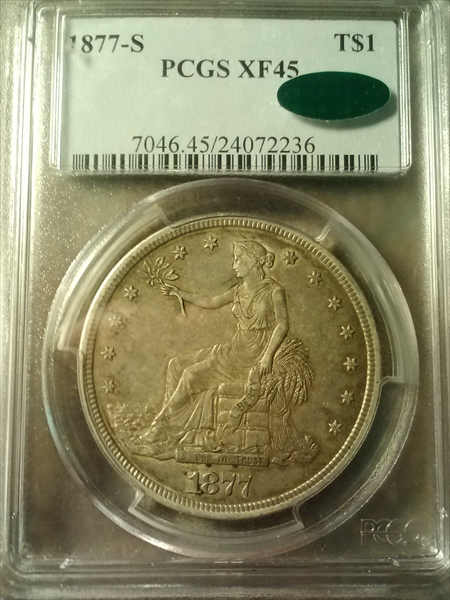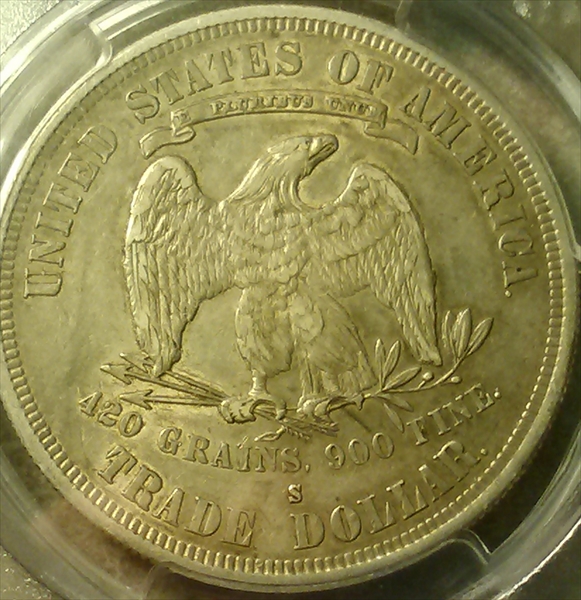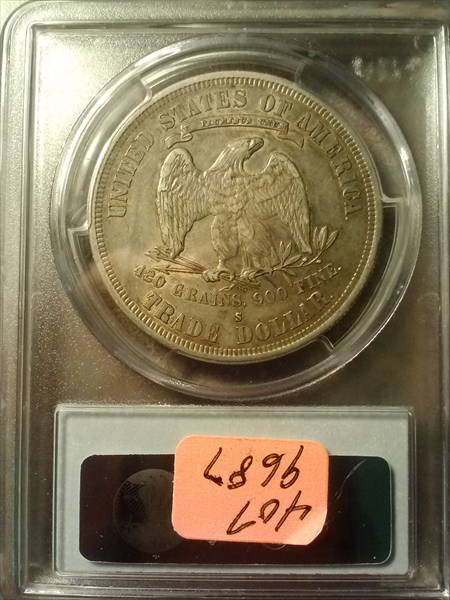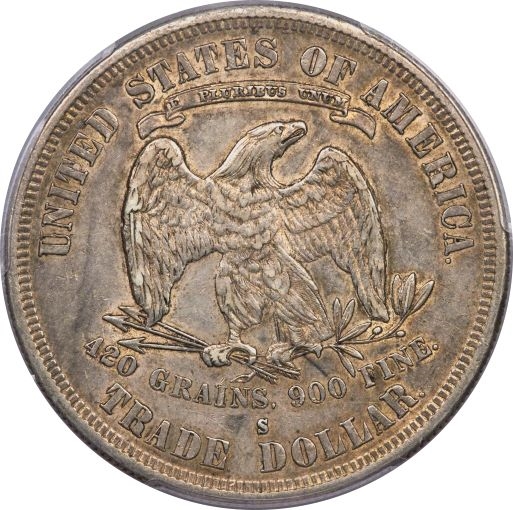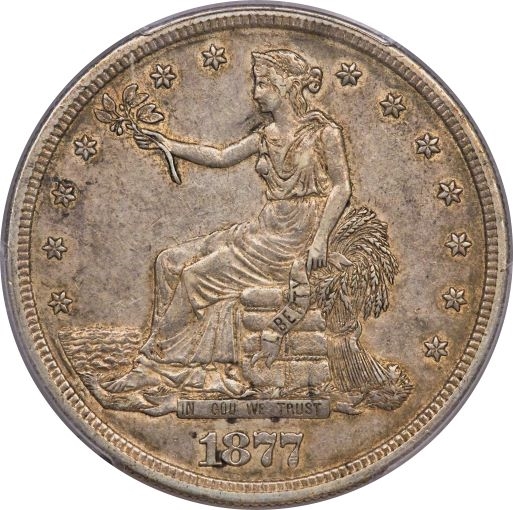1877-S T$1 XF45 认证号24072236, PCGS号7046
拥有者评论
CAC approved. Choice original XF45.
专家评论
Q. David Bowers
The following narrative, with minor editing, is from my "Silver Dollars & Trade Dollars of the United States: A Complete Encyclopedia" (Wolfeboro, NH: Bowers and Merena Galleries, Inc., 1993):Coinage Context
Record mintage: The mintage of the 1877-S trade dollar broke all previous records, and no later mintage was ever to equal it, with the result that the production of 9,519,000 pieces stands as the high point of the denomination. In fact, the mintage of 1877-S alone was greater than all combined trade dollar mintages of the Philadelphia and Carson City mints from the first year of circulation strike production, 1873, until the last year 1878!
The high-water mark for monthly trade dollar deliveries in 1877 at the San Francisco Mint was August, when 1,329,000 were ready for distribution.
Most shipped to China: Although some coins were distributed within the United States to brokers who bought them at a discount from face value and sold them to industrialists and others, by far the greatest amount of 1877-S trade dollars went to China, where they were plentiful for decades afterward. Many were made for the Nevada Bank of San Francisco (see Additional Information under 1877, above).
Numismatic Information Circulated grades: In grades from VF-20 to AU-58 the 1877-S is the most common of all trade dollars. I estimate that 50,000 or more exist. Chopmarked coins are also common.
Mint State grades: By comparison to other issues in the trade dollar series, the 1877-S is relatively "common" in Mint State, particularly in lower levels. I estimate that probably 50 to 100 or more MS-65 coins exist, a rare issue in absolute terms, but a common one relative to its cousins.
I estimate that 170 to 325 or more 1877-S trade dollars survive at the MS-64 level, 300 to 600 or more at the MS-63 level, and 1,750 to 3,500 or more in grades from MS-60 to 62.
Varieties: All authentic 1877-S trade dollars known to me to be of correct statutory weight (420+/- grains) are Type II/II. (See Additional Information below for so-called 1877-S Type II/I trade dollars.)
Varieties:
OBVERSE TYPE II, RIBBON ENDS POINT DOWN, 1876-1885
REVERSE TYPE II: NO BERRY BELOW CLAW, 1875-1885
Circulation strikes:
1. Minute s: Breen-5814. Mintmark .84 mm high.
Date numerals light, 1 and 8 apart. "Light Date." Rare.
2. Medium S: Mintmark 1.1 mm high. Date numerals heavy, 1 and 8 touch. "Heavy Date."
3. Large S. 1 8 free: Breen-5813. Mintmark 1.17 mm high. Date numerals light, 1 and 8 apart. "Light Date." Common. Many minor date position varieties. Often seen chopmarked.
4. Large S. 18 touching: Breen-5810. Mintmark 1.17 mm high. Date numerals heavy, 1 and 8 touch. "Heavy Date." Multiple dies. Common. Many minor date position varieties. Often seen chopmarked.
5. Large S. Doubled reverse die: Breen-5812.
Doubling plain on most letters. Rare. Bill Fivaz reports another, strongest on E PLURIBUS UNUM.(Letter to the author, January 29, 1992.)
6. Large S. Blunt tail to R of DOLLAR: Breen-5811. Upturned serif broken off. At least two positional varieties: (a) mintmark leans crazily to left; (b) S upright; normal periods. Both are presently considered to be rare.
7. Large S. Blunt tail to R of DOLLAR, but no periods after E of FINE or R of DOLLAR: Not in Walter Breen's Encyclopedia. Fewer than a dozen seen to date. Discovered by James R. Arnold (his specimen is EF and weighs 417.9 grains). The period after the final A in AMERICA is a tiny crescent. Evidently the hub was damaged. "Does this occur on 1878 trades of any mint?" asks Walter H. Breen.
Dies prepared: Obverse: 42; Reverse: 32. According to R.W. Julian, six obverses were ordered on November 24, 1876; six pairs were ordered on another date in November 1876; 18 obverses and 8 reverses were sent from Philadelphia on December 21, 1876 (apparently, all for 1877); 24 "dies of the best quality steel" were ordered on July 19, 1877.
Circulation strike mintage: 9,519,000. Delivery figures by month: January: 1,082,000; February: 863,000; March: 837,000; April: 876,000; May: 1,129,000; June: 312,000; July: 762,000; August: 1,329,000; September: 1,275,000; October: 481,000; November: none; December: 573,000. The die records may be incomplete; 42 obverses averages out to an extremely high 226,642 per die-pair.
Characteristics of striking: Usually seen well struck. However, among large mintage issues such as this there are many variations in striking quality. Some have a prooflike surface, especially on the obverse.
Known hoards of Mint State coins: None
Rarity with original Chinese chopmark(s): Extremely plentiful. Most common of all chopmarked trade dollars.
Commentary
1877-S is the highest mintage trade dollar and is the most common in all circulated grades, including chopmarked coins.
Additional Information
"1877-S II/I" Trade Dollars
From time to time a report surfaces about an 1877-S trade dollar with Type II obverse and Type I reverse. A specimen furnished for study by Larry Hylton is described as follows: Broken upper left serifs to E(S), (O)F, ME I. Large open S on reverse. 426.6 grains (abnormally heavy); ring somewhat dull, not prolonged or sonorous, not a box dollar.
A Type II/I specimen owned by Col. Eugene P. Wilson was reported decades ago but not seen by John M. Willem or Walter H. Breen (cf. Willem, p. 175); die description unknown. John Lazirko (Lazirko, p. 36) reports that an 1877-S Type I observed was a struck counterfeit.
Any authentic 1877-S II/I trade dollar (should one ever be found) is an anomaly, struck using a reverse die left over from an earlier year; an authentic piece in AU or Mint State grade should weigh within close tolerance of the authorized 420 grains, as the mints were very particular about the quality of trade dollars (for they were being sent to China, where weight and fineness were all-important). A specimen in EF grade should weigh in the range of 117 to 118 or so grains.
Ron Guth
For a comprehensive list of die varieties for this year, see William H. Cowburn, Jr.'s article in The Gobrect Journal, Vo.. 36, No. 106, 26-48.
PCGS #
7046
设计师
William Barber
边缘
Reeded
直径
38.10 毫米
重量
27.20 克
铸币数量
9519000
金属成分
90% Silver, 10% Copper
更高评级数量
2101
评级较低的钱币数量
870
地区
The United States of America
价格指南
PCGS 数量报告
拍卖 - PCGS 评级的
拍卖 - NGC 评级的
稀有性和存量估计 了解更多
| 所有评级 | 6500 |
| 60或以上 | 1500 |
| 65或以上 | 40 |
| 所有评级 | R-3.7 |
| 60或以上 | R-4.8 |
| 65或以上 | R-8.7 |
| 所有评级 | 18 / 18 |
| 60或以上 | 17 / 18 TIE |
| 65或以上 | 16 / 18 TIE |
| 所有评级 | 18 / 18 |
| 60或以上 | 17 / 18 TIE |
| 65或以上 | 16 / 18 TIE |





















